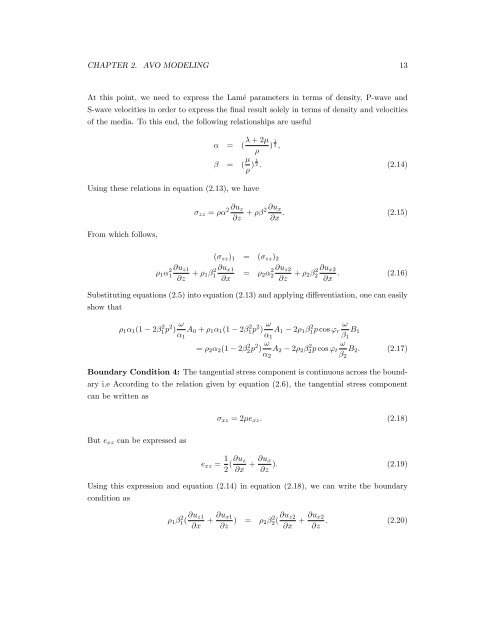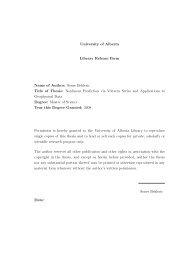Regularization of the AVO inverse problem by means of a ...
Regularization of the AVO inverse problem by means of a ...
Regularization of the AVO inverse problem by means of a ...
Create successful ePaper yourself
Turn your PDF publications into a flip-book with our unique Google optimized e-Paper software.
CHAPTER 2. <strong>AVO</strong> MODELING 13<br />
At this point, we need to express <strong>the</strong> Lamé parameters in terms <strong>of</strong> density, P-wave and<br />
S-wave velocities in order to express <strong>the</strong> final result solely in terms <strong>of</strong> density and velocities<br />
<strong>of</strong> <strong>the</strong> media. To this end, <strong>the</strong> following relationships are useful<br />
α = (<br />
Using <strong>the</strong>se relations in equation (2.13), we have<br />
From which follows,<br />
λ + 2µ<br />
)<br />
ρ<br />
1<br />
2 ,<br />
β = ( µ 1<br />
) 2 . (2.14)<br />
ρ<br />
2 ∂uz<br />
σzz = ρα<br />
∂z<br />
ρ1α 2 ∂uz1<br />
1<br />
∂z + ρ1β 2 ∂ux1<br />
1<br />
∂x<br />
(σzz)1 = (σzz)2<br />
∂ux<br />
+ ρβ2 . (2.15)<br />
∂x<br />
= ρ2α 2 ∂uz2<br />
2<br />
∂z + ρ2β 2 2<br />
∂ux2<br />
. (2.16)<br />
∂x<br />
Substituting equations (2.5) into equation (2.13) and applying differentiation, one can easily<br />
show that<br />
ρ1α1(1 − 2β 2 1p 2 ) ω<br />
A0 + ρ1α1(1 − 2β 2 1p 2 ) ω<br />
α1<br />
= ρ2α2(1 − 2β 2 2p 2 ) ω<br />
ω<br />
A1 − 2ρ1β<br />
α1<br />
2 1p cos ϕr B1<br />
β1<br />
A2 − 2ρ2β<br />
α2<br />
2 2p cos ϕt<br />
β2<br />
ω<br />
B2. (2.17)<br />
Boundary Condition 4: The tangential stress component is continuous across <strong>the</strong> bound-<br />
ary i.e According to <strong>the</strong> relation given <strong>by</strong> equation (2.6), <strong>the</strong> tangential stress component<br />
can be written as<br />
But exz can be expressed as<br />
σxz = 2µexz. (2.18)<br />
exz = 1<br />
2 (∂uz<br />
∂x<br />
∂ux<br />
+ ). (2.19)<br />
∂z<br />
Using this expression and equation (2.14) in equation (2.18), we can write <strong>the</strong> boundary<br />
condition as<br />
ρ1β 2 1( ∂uz1<br />
∂x<br />
∂ux1<br />
+<br />
∂z ) = ρ2β 2 2( ∂uz2<br />
∂x<br />
∂ux2<br />
+ . (2.20)<br />
∂z









